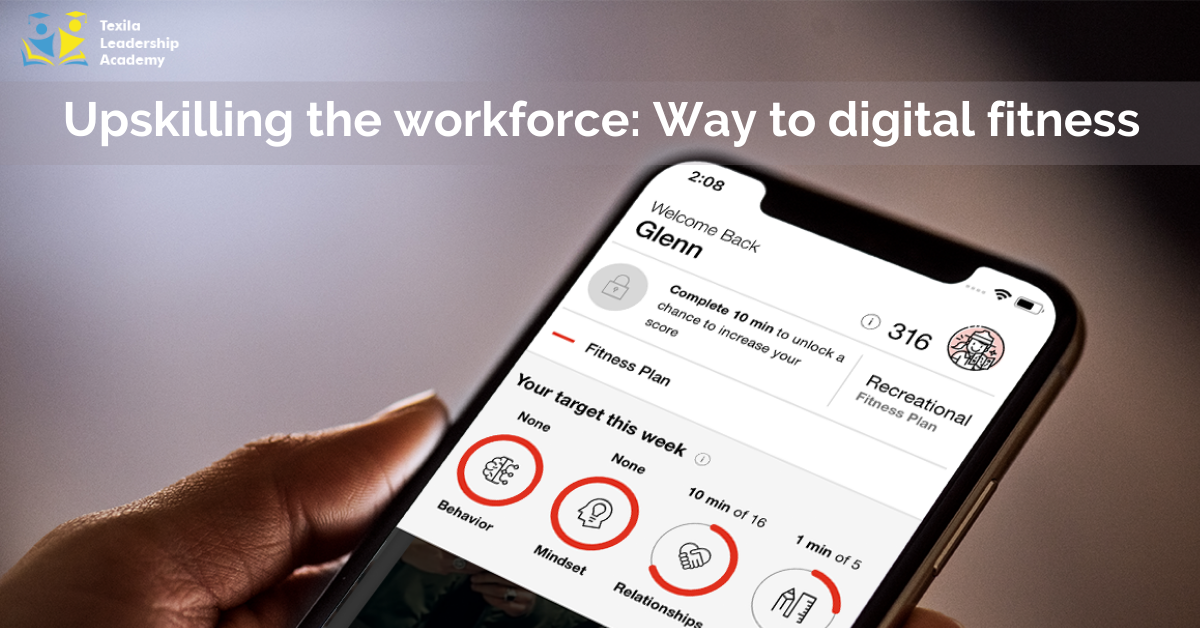What is upskilling?
Upskilling is equipping the employees with new skill sets and filling new positions from their current workforce. It helps and allows employees to fit in better positions within that company and fulfills the top talent needs of a rapidly changing economy.
Why is upskilling important?
To grow with better career prospects, employees need to stay relevant and updated with newer technology. In that regard, upskilling contributes significantly to the career graph. For the organization, it makes better business sense to train current employees rather than invest in hiring and training for a new recruit. Upskilling training allows employees to expand their skill set in line with the needs of the business. It promotes a learning atmosphere.
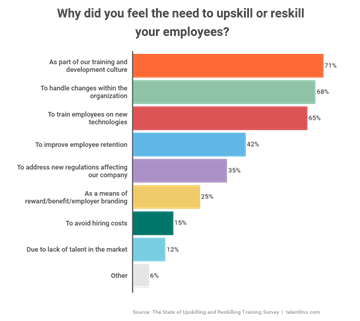
Here are some of the perks of upskilling:
- Enhancing competencies- Upskilling is a great way to increase competencies that provides a better chance to grow into managerial roles within an organization.
- Match organizational expectation- About 92% of the companies believe that an upskilled employee is an excellent choice for the company. This helps an employee stay on top of the company’s options when a senior role opens up.
- Drives business- When a company has better and upskilled employees, it does better in the market.
- Increases adaptability- Working as part of a team is essential in an organization. It has been observed that staying upskilled decreases conflict and improves teamwork.
- Productivity increases- Adding a new skill to the existing profile helps stay more productive and adopt “smart work” measures, thereby increasing efficiency.
- Lessens job shifts- The company has a better chance to promote an upskilled workforce, and such an employee is less likely to move jobs at least shortly.
- Short-term and long-term benefits- In the short-term, the organization benefits by gaining an upskilled workforce. As a long-term prospect, this upskilled workforce retains its core competencies as an asset to the company. The dual benefit comes into play due to long-term stay within the company, which is a great organizational benefit.
- An upskilled workforce is more flexible- When employees stay updated, additional support is around, and that is a mutual benefit.
- Employees learn more- Upskilling is one thing, but using the skill to gain hands-on experience is another aspect. Upskilled employees are often invited to offer a hand in need, and that can help the employee gain valuable experience.
- Imparts soft skills- When an employee acquires a valuable skill in technology, it also leaves behind soft skills such as communication, adaptability, and resilience.
- Personal and professional growth – Gaining technological skills gives the employee a sense of better self-confidence, employability, value and boosts his/her morale. Often employees look for career development in an organization.
- Encourages continual learning and development- Upskilling encourages and works better than an annual refreshment or a training program. It keeps the employee motivated and challenged.
Strategies in upskilling the workforce
- Identify the skill gaps- There is often a gap between where employees are and where they need to be in terms of skills. This is termed a skill gap. Identifying these gaps is the primary step to devising an upskilling strategy for the workforce and increasing productivity.
- Personal developmental plans- Employees should be encouraged to develop their opinions of what skills they lack to stay updated at work. They must be able to identify new skills that they need to learn to match up to.
- Workday amendments- The organization and the employee must work together to devise a plan to get a few hours off work, such as leaving early or working during the weekends. The employees must be provided with a time and space to take the skill class.
- Job-specific skills- The employee must be provided with an opportunity to acquire skills specific to the job. For example, a graphics software specialist must be updated with the newest software that will enable him/her to create graphics that suit the latest industry trends.
- Credentialing programs- When upskilling the workforce, a credential program is a good choice. It provides employees with the opportunity to get a certificate at the end, which could be added to their resume or social media profile. This will boost the employee’s morale and stay encouraged them to complete the program efficiently.
- Stay within budget- Companies may choose to provide upskilling training programs free of cost or at a discounted rate, making it pocket-friendly.
- Employ new trends- Modules and programs that fit into a busy schedule are the most efficient way to upskill the workforce. A classroom at work or online learning modules are good ways to go. Online learning modules encourage peer reviews which help each employee learn efficiently. In a classroom, trainers can help brainstorm ideas that are useful to the employees.
- Virtual classroom- In today’s time and age, it is good to adopt a virtual classroom setup as the learner’s progress can be tracked through analytics engines.
- Microlearning- To crunch time and make the best use of a workday, short 5 to 10 min videos/modules may be sent to the learners to facilitate quick learning.
- Lunch learning sessions- The concept of learning over lunch is slowly picking up. They are a great idea as it is an informal session to brainstorm, discuss and learn. Companies may provide a complementary or subsidized meal as part of the session.
Ways to upskill the workforce
Identify future Skills and skill gaps.
Skill gaps need to be identified across three main laterals.
- The company as a whole
- Individual departments/ units
- Individual employees
It makes more business sense for a vast and diverse organization to bridge the gap across various departments or units such as sales and marketing. Employees must have a PDP in place, which needs to be supported by the company.
Assess Skills
Identifying existing skills within the company and make a note of core competencies that contribute to them. Devise a plan of how to start and where. Then, it becomes easier and organized the way up.
Set goals
Break down goals into smaller units. Identify the company’s plans, the business unit, and each employee. Note down the goals at various levels and then strategize ways to work up towards those. Take a poll or survey among employees on what skills they would like to acquire, what the company’s business leaders have in mind, consider both of these, and come to a conclusion.
Job rotation
Moving employees between positions laterally enable knowledge and skill transfer to be used interchangeably upon skill set approval. This will become a practical experience as an application of skill set management.
Job enlargement and enrichment
When employees are trusted with the responsibility of more work and commitment, they develop a wide variety of skills that adds value and extra dimensions to existing profiles.
Outsourcing training
Senior and previously upskilled employees can train existing employees who need upskilling. But upskilling the workforce is an important reason to outsource training to industry experts, thereby speeding up the training capabilities and move towards increased productivity.
Employee learning
Online- About 63% of employees look for online resources, and search engines said they go to specific websites, while 53% used a search engine. It is a convenient tool for employees on the go and makes better time and economic sense.
Team learning– Almost 44% of workers looked for guidance among their peers and colleagues to gain knowledge. For example, an employee will be a part of the Agile workshop to gain insights and stay updated with the latest trends.
Peer coaching- 33% of employees ask their co-workers for help or go to social networks and be part of online communities. For example, A marketing executive will look for ways to close a deal on the call or methods to deal with an angry customer.
Today, more and more employees realize the need for talent development programs for their employees, where they are more likely to stay. Organizations need to make learning blended and personalized so that it becomes an exciting experience that grows a community of upskilled employees who will contribute enough and more to the company. This must happen irrespective of the employee’s run with the company.
Skill assessment
The goal of upskilling the workforce is to fill the skill gaps. A metric system to assess skill assessment is essential to see if the goal has been realized yet and ways to improve through feedback from mentors and employees alike. These metrics may include a skills inventory, skills ratings, and skills progression with the skill gap assessment and fulfillment.
Certain specific areas where skills need to be analyzed:
- Identify trending skills (with employee rating from high to low)
- Department-specific skills (Finance, Engineering, IT)
- Group skills (Interdisciplinary communications in Sales)
- Role-specific skills (Marketing vs. Agile developer)
- Skill certifications, badges, credentials earned (from multiple sources)
- Make opportunities for skills gained
Applying the upskilled workforce to new and innovative projects will develop a better contribution to the company. The employee’s learning will be a continuous process and enable managers to identify existing talent. Every day is dynamic in a company, and this learning can help deal with the ever-growing needs of the organization.
Tools for upskilling workforce
Some practical tools in use are:
Docebo LMS
It is a learning management system that enables you to manage, deliver, and measure e-learning programs. This tool provides your training materials in various formats and uses AI.
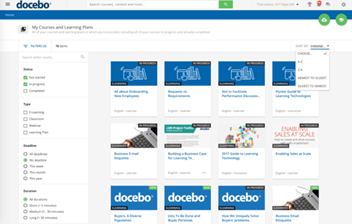
GoToTraining
It is a tool that lets you make video training a part of your upskilling. Whether you’re inviting an in-house or an industry expert, the training will be online.
An expert belonging to your company’s overseas branch can train your team members through GoToTraining. This tool allows you to schedule meetings that are similar to personal training. There is a screen-sharing option that dramatically helps in getting the point across to learners.
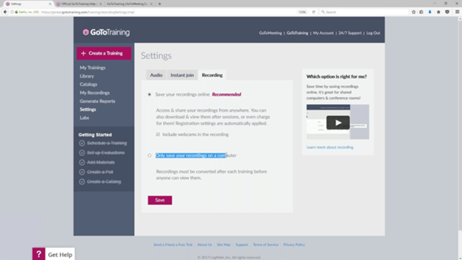
Another exciting feature of the program is that it also provides integrations with YouTube and Vimeo that will help you link relevant videos specific to your courses.
Bloomfire
It is a document management platform that allows you to centralize your company’s knowledge. Training document development takes a lot of time and effort, and saving them as long as the trends stay relevant is part of training resource management.
It will help learners get back to the information whenever needed and also helpful for multiple batches alike. It can become a part of the company’s training history and records. Bloomfire offers the option to collate, making it easier for the learner to see the documents in one place.
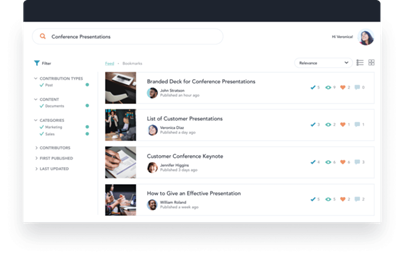
Grovo
When microlearning is the way to go due to time or financial constraints, Provo is a great platform that makes way for employee attention with bite-sized information. There is an option to customize the lessons according to the industry you are in or specific to your employees.
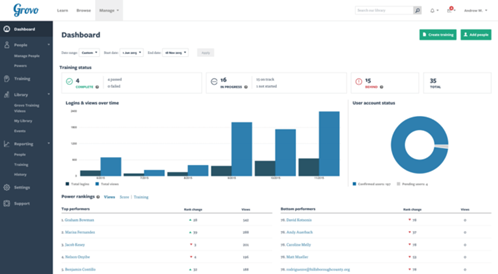
Trello
This tool helps you to stay organized while upskilling the workforce. It allows you to create boards where team members can be added to the learning modules. It has an exciting feature where team members can individually see and track their progress during the training. The members can give feedback, and the trainer can provide replies.

How to encourage employees to upskill themselves
To effectively upskill the workforce, employees must stay motivated for various reasons and complete the training. Some of the productive ways to do it are:
- Let training be a part of your culture.
- When employees see that your company has a culture of career development for its employees, they will become habituated.
- Enhance training and offer perks
- Each employee’s personal and career needs are very different, and hence their training also needs to be personalized. It will give them space to grow and learn.
- Resource access for continued learning so that employees can use online tools, workshops, conferences, etc. Research shows that about 94% of employees stay longer at a company that offers career advancement opportunities.
- When training is linked to career advancement and promotion opportunities, employees upskill effectively and are retained better.
- Incentivize and recognize training achievements
When employees feel their efforts are recognized, they perform better and stay motivated for other learning programs. A sense of achievement and an incentive keeps them going. Thereby the company gains an upskilled workforce in the long run. - Make it a perk for top performers.
When employees see that education and training within the company at no cost to them are available for top performers in their department, they will begin to work towards it and become efficient as part of upskilling the workforce.
- Show interest in employee’s career.
When the company shows an interest in an employee’s career, they are naturally motivated to learn. Show them that you are aligning the training and development along with their career graphs. This will keep them at completing the training effectively and contributing to the company with the newly acquired skill set.
- Regular performance reviews
A performance review will enable the upskilling of the workforce process to bear fruit and increase company growth. It motivates employees to see how far they come from where they were. It will interest them to acquire additional skills.
Tips for Employees - Ask for work outside of your usual realm – This will promote collaboration among your peers and help you acquire the job skill. But make sure all this is done while fulfilling your current responsibilities effectively and do not compromise on your recent performance.
- Stay connected- Identify leaders in your industry over social media and stay connected with them over YouTube, Linked In, etc. This helps you stay up-to-date latest advancements you may put forward to the company as part of your feedback and aspiration.
- Become a member of a professional organization. Sometimes organizations require special certifications or updates to your qualification to do so. You may achieve this through CE programs, networking, or internships.
- Some employees support further education, such as post-graduation, to upskill the workforce and value your contribution to the company.
Upskilling the workforce in the post-pandemic world has become a necessity to stay relevant across industries. It is instead a need more than an option or luxury. A 2017 Productivity Commission report says “the combined effect of an aging workforce and technological change” is the driving factor behind the growing skills gap in the workforce.
With economies just picking up in the post-pandemic world, it becomes imperative that companies and employees stay relevant and survive the wave of uncertainty and financial upheaval, gain and impart valuable skills in the process.

